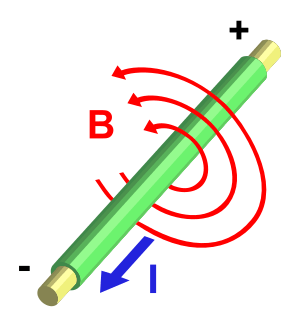Ampère's circuital law facts for kids
Ampère's circuital law is a rule about how magnetic fields are created by electric currents. It was discovered by a scientist named André-Marie Ampère in 1826. This law is now a key part of Maxwell's equations, which are the main rules that explain electromagnetism in classical physics.
Contents
What is Ampère's Law?
Ampère's law helps us understand the connection between magnetic fields and the electric currents that make them. Imagine electricity flowing through a wire; this law helps you figure out the magnetic field around that wire. It can also help you find the current if you know the magnetic field.
This law works best when things are "magnetostatic." This means the electric currents are steady and not changing over time. If the electric field is changing, the original law needs a special update, which we'll talk about later.
The law can be written in different ways, but they all mean the same thing. The main idea is that if you follow a closed path around an electric current, the magnetic field along that path is directly related to the amount of current passing through the loop.
How to use the law (simply)
To use Ampère's law, you imagine a closed loop, like a circle or a square.
- You look at the magnetic field all along this loop.
- You also look at all the electric current that passes through the area inside your loop.
- The law says there's a direct link between the strength of the magnetic field around the loop and the total current going through it.
Think of it like this: the more current that goes through your imaginary loop, the stronger the magnetic field will be around that loop.
Free Current vs. Bound Current
When we talk about electric current, there are two main types:
- Free current is what you usually think of, like electricity flowing through a metal wire or from a battery. These charges can move freely.
- Bound current happens inside materials. For example, when you put a material in a magnetic field, the tiny electrons inside its atoms might move a little. They stay attached to their atoms, but their movement creates a small, internal current. This is called "magnetization current."
Another type of bound current comes from "bound charges." In some materials, an electric field can make positive and negative charges in molecules separate a tiny bit. If these charges move, it creates a "polarization current."
All these currents are basically the same at a very tiny level. But for practical reasons, scientists often separate them. The total current is the sum of free current, magnetization current, and polarization current.
Why the Original Law Needed an Update
The original Ampère's law worked well for steady currents. But scientists found two problems when things were changing:
1. Charge Conservation: Electricity doesn't just appear or disappear. If charge is building up or moving, the original law didn't quite fit. For example, in a capacitor (a device that stores charge), current flows to charge it up, but there's no actual current flowing between the plates. The original law couldn't explain the magnetic field in that gap.
2. Electromagnetic Waves: The original law couldn't explain how light and other electromagnetic waves could travel through empty space. If there was no current, the law said there should be no changing magnetic field, but we know light travels everywhere!
To fix these issues, a scientist named James Clerk Maxwell added something new to Ampère's law. He called it "displacement current."
What is Displacement Current?
Maxwell realized that a changing electric field could also create a magnetic field, just like a moving electric current does. He called this effect "displacement current."
- Even in empty space (a vacuum), if an electric field is changing, it acts like a current and creates a magnetic field. This is super important for understanding how light travels.
- In materials, the displacement current also includes the effect of charges moving slightly within molecules (polarization current), as we mentioned earlier.
Maxwell's idea of displacement current was a huge breakthrough. It helped explain:
- How magnetic fields exist even where no regular current flows (like between capacitor plates).
- How electromagnetic waves (like light, radio waves, X-rays) can travel through space.
The Maxwell–Ampère Equation
With Maxwell's addition, Ampère's law became more complete and is now known as the Maxwell–Ampère equation. This updated law is one of the four Maxwell's equations that describe all of electromagnetism.
The new law says that a magnetic field can be created by two things:
- Actual electric currents (both free and bound currents).
- A changing electric field (the displacement current).
This complete law correctly predicts how magnetic fields behave in all situations, whether currents are steady or changing, and whether they are in materials or empty space. It was a key step in understanding that light is an electromagnetic wave.
See also
|
|
See also
 In Spanish: Ley de Ampère para niños
In Spanish: Ley de Ampère para niños


